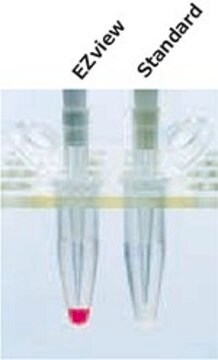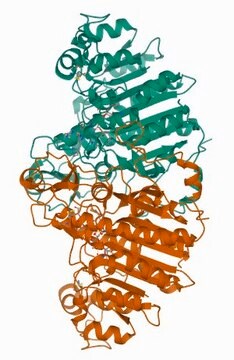A4596
Affinitätsgel ANTI-FLAG® M1 Agarose
Synonym(e):
Anti-ddddk, Anti-dykddddk
About This Item
Empfohlene Produkte
Konjugat
agarose conjugate
Qualitätsniveau
Antikörper-Produkttyp
primary antibodies
Form
suspension
Isotyp
IgG12b
Kapazität
≥0.6 mg/mL, gel binding capacity
Lagertemp.
−20°C
Allgemeine Beschreibung
Spezifität
N-Asp-Tyr-Lys-Asp-Asp-Asp-Asp-Lys-C
Anwendung
Das Affinitätsgel ist für die Calcium-vermittelte Aufreinigung von Fusionsproteinen mit N-terminalem FLAG bestimmt.
Immunpräzipitation (IP): geeignet
Elution – FLAG-Peptid, Glycin, pH 3,5 EDTA
Weitere Produktinformationen finden Sie in unserem FLAG® Literatur-Portal.
Leistungsmerkmale und Vorteile
- Üblicherweise werden Fusionsproteine aus Rohlysaten in nur einem Chromatographieschritt bis zur Einzelbanden-Reinheit gereinigt.
- Fusionsprotein kann durch milde Elution mit EDTA vom Affinitätsharz eluiert werden.
- Eine Lösung aus FLAG-Peptid kann zur schonenden, nicht denaturierenden Elution von FLAG-Fusionsproteinen verwendet werden.
Physikalische Form
Sonstige Hinweise
Rechtliche Hinweise
Sie haben nicht das passende Produkt gefunden?
Probieren Sie unser Produkt-Auswahlhilfe. aus.
Ähnliches Produkt
Lagerklassenschlüssel
10 - Combustible liquids
WGK
WGK 3
Flammpunkt (°F)
Not applicable
Flammpunkt (°C)
Not applicable
Analysenzertifikate (COA)
Suchen Sie nach Analysenzertifikate (COA), indem Sie die Lot-/Chargennummer des Produkts eingeben. Lot- und Chargennummern sind auf dem Produktetikett hinter den Wörtern ‘Lot’ oder ‘Batch’ (Lot oder Charge) zu finden.
Besitzen Sie dieses Produkt bereits?
In der Dokumentenbibliothek finden Sie die Dokumentation zu den Produkten, die Sie kürzlich erworben haben.
Kunden haben sich ebenfalls angesehen
Verwandter Inhalt
Protein purification techniques, reagents, and protocols for purifying recombinant proteins using methods including, ion-exchange, size-exclusion, and protein affinity chromatography.
Protein expression technologies for expressing recombinant proteins in E. coli, insect, yeast, and mammalian expression systems for fundamental research and the support of therapeutics and vaccine production.
Unser Team von Wissenschaftlern verfügt über Erfahrung in allen Forschungsbereichen einschließlich Life Science, Materialwissenschaften, chemischer Synthese, Chromatographie, Analytik und vielen mehr..
Setzen Sie sich mit dem technischen Dienst in Verbindung.














